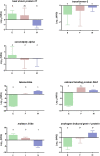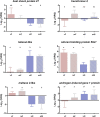Transcriptome analysis of Anastrepha fraterculus sp. 1 males, females, and embryos: insights into development, courtship, and reproduction
- PMID: 33339505
- PMCID: PMC7747455
- DOI: 10.1186/s12863-020-00943-2
Transcriptome analysis of Anastrepha fraterculus sp. 1 males, females, and embryos: insights into development, courtship, and reproduction
Abstract
Background: Anastrepha fraterculus sp. 1 is considered a quarantine pest in several American countries. Since chemical control applied in an integrated pest management program is the only strategy utilized against this pest, the development of pesticide-free methods, such as the Sterile Insect Technique, is being considered. The search for genes involved in sex-determination and differentiation, and in metabolic pathways associated with communication and mating behaviour, contributes with key information to the development of genetic control strategies. The aims of this work were to perform a comprehensive analysis of A. fraterculus sp. 1 transcriptome and to obtain an initial evaluation of genes associated with main metabolic pathways by the expression analysis of specific transcripts identified in embryos and adults.
Results: Sexually mature adults of both sexes and 72 h embryos were considered for transcriptome analysis. The de novo transcriptome assembly was fairly complete (62.9% complete BUSCO orthologs detected) with a total of 86,925 transcripts assembled and 28,756 GO annotated sequences. Paired-comparisons between libraries showed 319 transcripts differently expressed between embryos and females, 1242 between embryos and males, and 464 between sexes. Using this information and genes searches based on published studies from other tephritid species, we evaluated a set of transcripts involved in development, courtship and metabolic pathways. The qPCR analysis evidenced that the early genes serendipity alpha and transformer-2 displayed similar expression levels in the analyzed stages, while heat shock protein 27 is over-expressed in embryos and females in comparison to males. The expression of genes associated with courtship (takeout-like, odorant-binding protein 50a1) differed between males and females, independently of their reproductive status (virgin vs mated individuals). Genes associated with metabolic pathways (maltase 2-like, androgen-induced gene 1) showed differential expression between embryos and adults. Furthermore, 14,262 microsatellite motifs were identified, with 11,208 transcripts containing at least one simple sequence repeat, including 48% of di/trinucleotide motifs.
Conclusion: Our results significantly expand the available gene space of A. fraterculus sp. 1, contributing with a fairly complete transcript database of embryos and adults. The expression analysis of the selected candidate genes, along with a set of microsatellite markers, provides a valuable resource for further genetic characterization of A. fraterculus sp. 1 and supports the development of specific genetic control strategies.
Keywords: Differential gene expression; Fruit fly; Microsatellite markers; RNA-Seq analysis; Transcript annotation.
Conflict of interest statement
The authors declare no competing financial interests.
Figures





Similar articles
-
Head Transcriptomes of Two Closely Related Species of Fruit Flies of the Anastrepha fraterculus Group Reveals Divergent Genes in Species with Extensive Gene Flow.G3 (Bethesda). 2016 Oct 13;6(10):3283-3295. doi: 10.1534/g3.116.030486. G3 (Bethesda). 2016. PMID: 27558666 Free PMC article.
-
Plant-Mediated Female Transcriptomic Changes Post-Mating in a Tephritid Fruit Fly, Bactrocera tryoni.Genome Biol Evol. 2018 Jan 1;10(1):94-107. doi: 10.1093/gbe/evx257. Genome Biol Evol. 2018. PMID: 29220418 Free PMC article.
-
Male sexual enhancement after methoprene treatment in Anastrepha fraterculus (Diptera: Tephritidae): A sustained response that does not fade away after sexual maturation.J Insect Physiol. 2017 Aug;101:7-14. doi: 10.1016/j.jinsphys.2017.06.009. Epub 2017 Jun 13. J Insect Physiol. 2017. PMID: 28623148
-
Genetics and biology of Anastrepha fraterculus: research supporting the use of the sterile insect technique (SIT) to control this pest in Argentina.BMC Genet. 2014;15 Suppl 2(Suppl 2):S12. doi: 10.1186/1471-2156-15-S2-S12. Epub 2014 Dec 1. BMC Genet. 2014. PMID: 25471175 Free PMC article. Review.
-
How functional genomics will impact fruit fly pest control: the example of the Mediterranean fruit fly, Ceratitis capitata.BMC Genet. 2014;15 Suppl 2(Suppl 2):S11. doi: 10.1186/1471-2156-15-S2-S11. Epub 2014 Dec 1. BMC Genet. 2014. PMID: 25471105 Free PMC article. Review.
Cited by
-
Integrated Full-Length Transcriptome and RNA-Seq to Identify Immune System Genes from the Skin of Sperm Whale (Physeter macrocephalus).Genes (Basel). 2021 Feb 5;12(2):233. doi: 10.3390/genes12020233. Genes (Basel). 2021. PMID: 33562637 Free PMC article.
-
Joint FAO/IAEA coordinated research project on "comparing rearing efficiency and competitiveness of sterile male strains produced by genetic, transgenic or symbiont-based technologies".BMC Genet. 2020 Dec 18;21(Suppl 2):148. doi: 10.1186/s12863-020-00931-6. BMC Genet. 2020. PMID: 33339502 Free PMC article. No abstract available.
References
-
- Norrbom AL, Zucchi RA, Hernández-Ortiz V. Phylogeny of the genera Anastrepha and Toxotrypana (Trypetinae: Toxotrypanini) based on morphology. In: Aluja M, Norrbom AL, editors. Fruit flies (Tephritidae): phylogeny and evolution of behavior. Boca Raton: CRC Press; 1999.
-
- Norrbom AL. Host plant database for Anastrepha and Toxotrypana (Diptera: Tephritidae: Toxotrypani), Diptera Data Dissemination Disk. CD. 2004.
-
- Zucchi RA. Diversidad, distribución y hospederos del género Anastrepha en Brasil. In: Hérnandez-Ortiz V, editor. Moscas de la fruta en Latinoamérica (Diptera: Tephritidae): Diversidad, biología y manejo. S y G editores, Distrito Federal. 2007. pp. 77–100.
-
- Cladera JL, Vilardi JC, Juri M, Paulin LE, Giardini MC, Gómez Cendra PV, et al. Genetics and biology of Anastrepha fraterculus: research supporting the use of the sterile insect technique (SIT) to control this pest in Argentina. BMC Genet. 2014;15(Suppl 2):S12. doi: 10.1186/1471-2156-15-S2-S12. - DOI - PMC - PubMed
Publication types
MeSH terms
LinkOut - more resources
Full Text Sources

